By Charles Denson
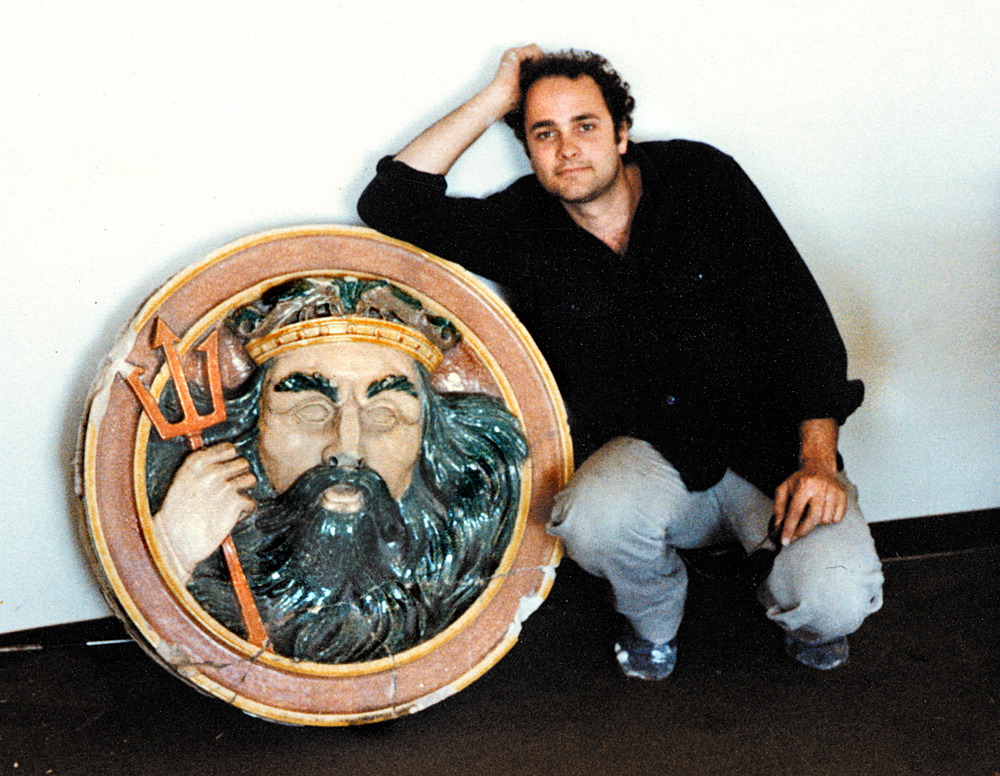
Charles Denson with the Neptune medallion on the day he donated it to the Brooklyn Museum in 1981.
On November 20 a groundbreaking exhibition called Coney Island: Visions of an American Dreamland opens at the Brooklyn Museum. The connection between this show and the Brooklyn Museum has unleashed a flood of memories about my life-changing experiences at the museum fifty years ago.
In 1965, when I was in the sixth grade at P.S. 288 in Coney Island, I won an art contest for a drawing I did of the newly built Verrazano Bridge. The drawing was exhibited in a student art show at the Lever House gallery on Park Avenue in Manhattan. My class made a trip to see the show, and my prize was a scholarship to attend summer art school at the Brooklyn Museum.
Attending classes at the museum was one of the highlights of my childhood and I fell in love with the museum’s galleries and art school. My favorite part was the sculpture garden next to the parking lot behind the museum. At that time it was more of a junkyard than a garden. Rarely opened to the public, it was a cluttered storage area stacked with architectural artifacts rescued from demolition sites all over New York. I loved wandering among these beautiful rescued objects, and I couldn't believe that these treasures were all that remained from historic buildings that were being destroyed across the city.
The garden later became more formal and was transformed into an important part of the museum. I thought of the garden as the city's architectural “lost and found” department, where lost objects might be found and (I hoped) someday appreciated and returned to their rightful places in the fabric of the city.
During the late 1960s I began rescuing artifacts from demolition sites all over my Coney Island neighborhood. It was not like today when architectural fragments are scavenged and sold off to the highest bidder. Beautiful buildings and their decorative ornamentation were crushed into dust below the treads of bulldozers and loaded into dump trucks. I literally worked behind bulldozers gathering anything I could. The horror of urban renewal was in full swing, and I’d become a preservationist.
In 1973 a beautiful Boardwalk structure called the Washington Baths Annex was being demolished after a series of fires. The building, which we called the Pink Palace, was clad in shiny pink terra-cotta and decorated with nautical-themed medallions. After a great deal of effort, I rescued one of the structure’s shattered King Neptune medallions, took it home, and repaired it with plaster and pieces of metal coat hangers. Ten years later I donated the medallion to the Brooklyn Museum where it was put on display in a kiosk in the sculpture garden alongside other salvaged Coney Island artifacts. King Neptune had found a permanent home!
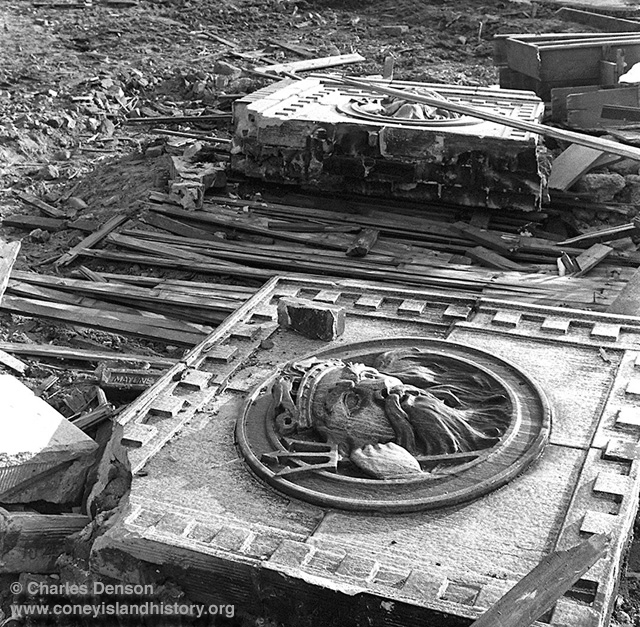
The King Neptune medallion in the ruins of Washington Baths, 1973. © Charles Denson
I began documenting Coney Island at the age of twelve with the eventual goal of writing a book. It took me nearly forty years of primary source research to complete Coney Island: Lost and Found, and it was finally published in 2002. It was well received and won the New York Book of the Year Award from the New York Society Library. As I described in the book, the title “Lost and Found” was based on my early experiences at the Brooklyn Museum and my love of its sculpture garden and artifacts.
In 2009 Robin Jaffee Frank, then at Yale, asked me to be one of the consultants for an extensive Coney Island exhibition she was proposing, and I joined an impressive team that she assembled to plan the show. We met many times, and I wound up writing the final chapter of the exhibition catalog. I was also thrilled to have my work included in the show, and to contribute photographs and ephemera to what I consider to be the best Coney Island exhibit ever assembled, a sensational show that has now come home to Brooklyn.
My early experiences at the Brooklyn Museum have come full circle, and some of what was lost during my childhood has been found. The King Neptune medallion will be on display at the Brooklyn Museum as part of Visions of an American Dreamland, partnered with some of the greatest Coney artwork ever exhibited. Many of the exquisite and rarely seen nineteenth century Coney Island paintings in the show are masterpieces that I’d studied but had never seen in person before: depictions of an undeveloped natural landscape bearing little resemblance to the modern cityscape of my old neighborhood.
Robin Jaffee Frank’s illuminating exhibition is comprised of 140 pieces: classical paintings, photographs, carousel horses, artifacts, films, posters, prints, and works by Paul Cadmus, George Tooker, Weegee, Diane Arbus, Bruce Davidson, Reginald Marsh, Red Grooms, Joseph Stella, and many others who captured the essence and spirit of Coney Island. This show takes me back to my Coney Island roots and intensifies my deep appreciation for the Brooklyn Museum and what I learned there in my youth.
"Coney Island: Visions of an American Dreamland, 1861-2008," Brooklyn Museum, November 20, 2015-March 13, 2016. The museum is open Wed - Sun, 11am - 6pm, on Thursdays til 10pm, and on the first Saturday of the month til 11pm.
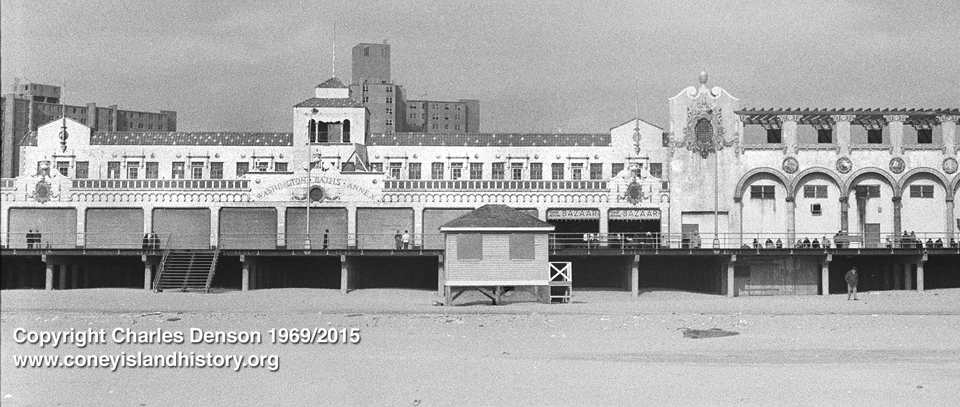
Washington Baths Annex, at left, next to the Childs Building, 1969 © Charles Denson
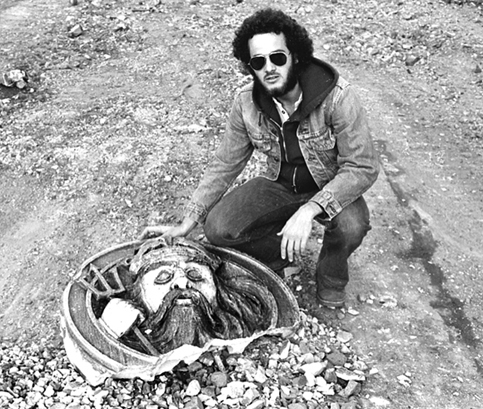
Charles Denson, 1973, rescuing Neptune medallion.
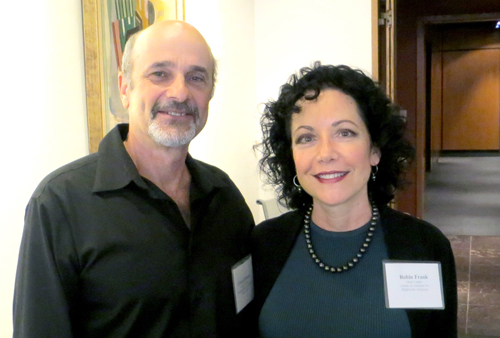
Charles Denson and curator Robin Jaffee Frank at the Wadsworth Atheneum, 2013.

Comments
Brooklyn Museum
As a born and bred Coney Islander I too love all the old that was saved. My father worked at Dreamland and I have his Dreamland badge as well as a Dreamland fishing game token. The Brooklyn Museum's lost objects out door area was one of my favorites as well. We used to try to correctly name the pieces we saw there and guess where they came from. I am thrilled that the Brooklyn Museum is giving Coney Island the kind of exhibit that will thrill many.
Washington Baths
Hi Mr. coney Island,
I loved your article regarding the Washington Baths. I read a lot about the history of Washington Baths by reading your book and online article, but never actually found a lot of pictures of it exterior and especially interior - not annex pictures but main building. It is amazing how beautiful it must have been outside. Your art deco Neptune medallion that you were able to salvage and donate looked amazing. Can you point me to a reference to learn more about this beautiful building?
Add new comment